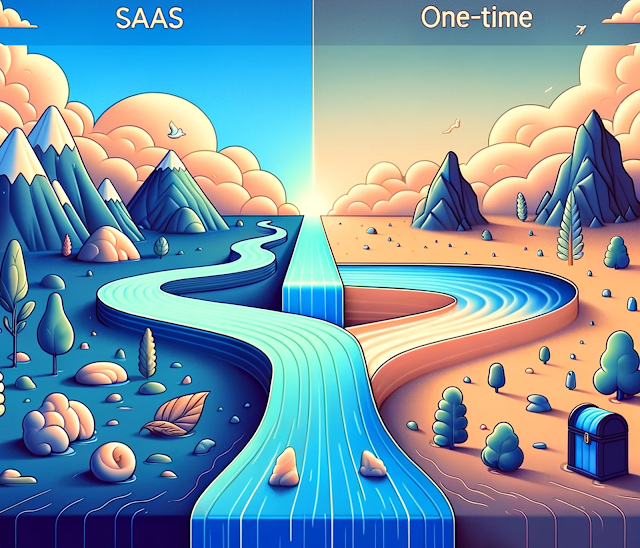The question of whether customers have a higher Lifetime Value (LTV) with a Software as a Service (SaaS) / membership model compared to a one-time revenue structure is multifaceted, involving considerations around customer behavior, pricing strategies, value delivery, and business sustainability. The core difference between the two models is that SaaS/membership models rely on recurring revenue from subscriptions or memberships, while one-time revenue models rely on single transactions for products or services.
Relevant Templates:
SaaS / Membership Advantages
- Predictable Revenue: SaaS or membership models provide businesses with predictable, recurring revenue. This allows for better financial planning and stability. Recurring revenue can also increase the overall lifetime value of a customer as long as the customer retention rate is high. You will see valuations go up with strong recurring revenue.
- Customer Relationship: These models encourage ongoing relationships with customers, providing opportunities for businesses to continually deliver value and engage with their customer base. This relationship can lead to higher customer satisfaction and loyalty, potentially increasing LTV.
- Upsell and Cross-sell Opportunities: With a closer relationship and ongoing interactions, there are more opportunities to introduce customers to other products or services, or to higher tiers of their current subscription, effectively increasing their LTV.
- Continuous Improvement and Value: SaaS and membership models rely on continuous service or product improvement to retain customers. This commitment to enhancement can lead to higher perceived value and satisfaction among customers, potentially increasing their LTV. It is also expensive, so plan accordingly.
One-Time Revenue Advantages
- High Initial Revenue: One-time transactions can provide a significant upfront cash flow. This is particularly beneficial for products or services with high acquisition costs or for businesses that require large initial capital.
- Simplicity: For both customers and businesses, the one-time model is straightforward. There's no need for complex billing systems or continuous sales efforts to retain customers.
- Lower Commitment: Customers may be more willing to make a one-time purchase than to commit to a recurring payment, especially for higher-priced items or services.
Leading Theories and Case Studies
- Customer Lifetime Value (CLV) Models: These models assess the profitability of customer relationships based on revenue generated over time, costs of acquisition, and retention costs. They often show higher LTV for subscription models due to recurring revenue, assuming customer retention strategies are effective.
- Behavioral Economics: Theories in this area, such as the Endowment Effect and Loss Aversion, suggest that once customers are accustomed to a service (as in a subscription model), they value it more highly and are reluctant to lose access, potentially increasing LTV.
- Case Studies: Companies like Adobe and Microsoft have transitioned from one-time purchase models to subscription-based services (Adobe Creative Cloud, Microsoft 365) with significant success. These transitions have often resulted in increased revenue per user and improved customer engagement and satisfaction.
Conclusion
Whether a SaaS/membership model or a one-time revenue structure results in a higher LTV depends on numerous factors, including the nature of the product/service, market conditions, and the effectiveness of customer retention strategies. SaaS/membership models have the potential for higher LTV through recurring revenue and enhanced customer relationships, but they require careful management of customer satisfaction and retention. One-time revenue models might be more suitable for products or services with limited scope for continuous improvement or for customer segments that prefer straightforward transactions. The optimal model varies by industry, product type, and customer preferences.
You may also be interest in the "Rule of 40" in SaaS.
Article found in SaaS.
